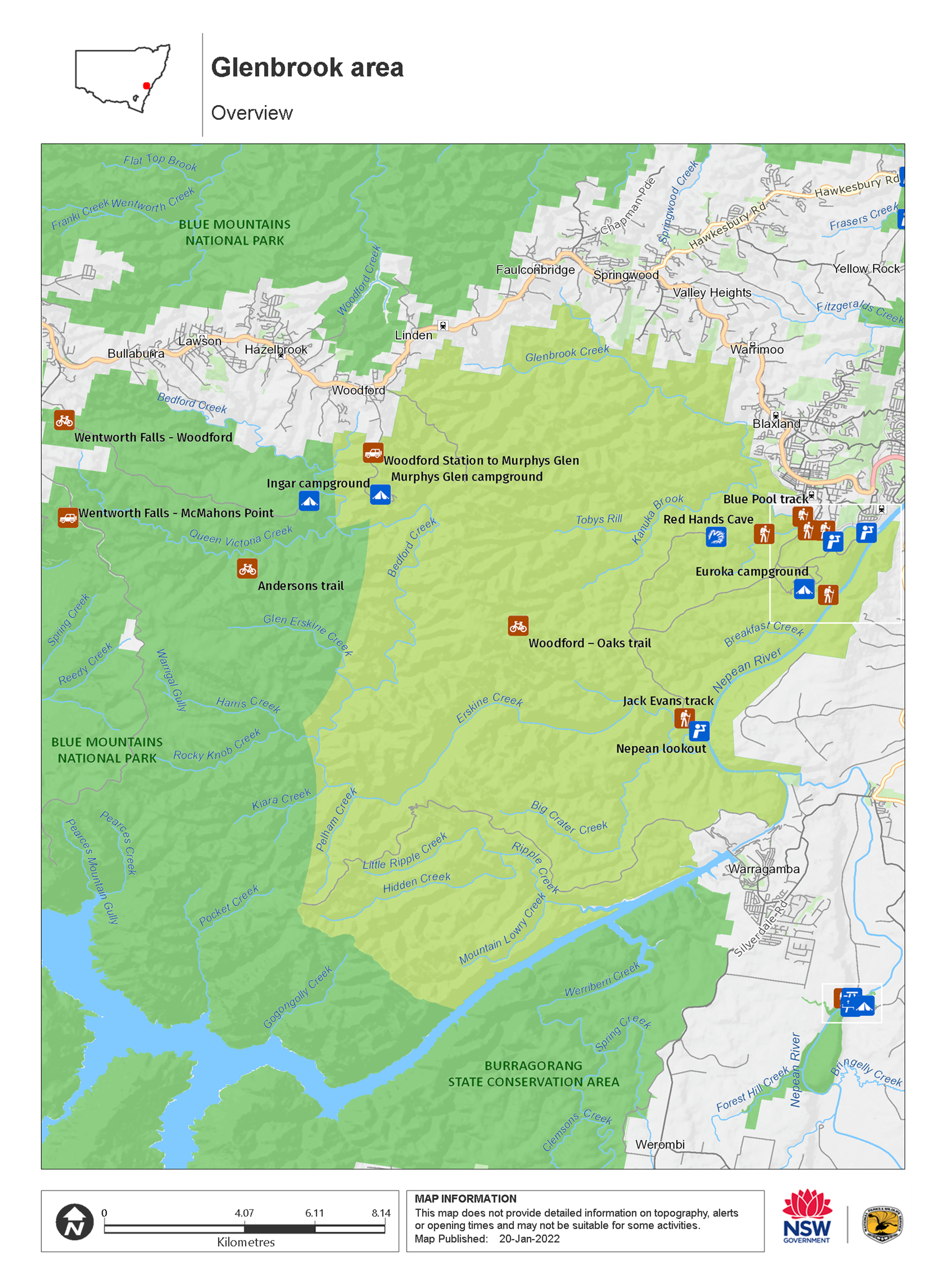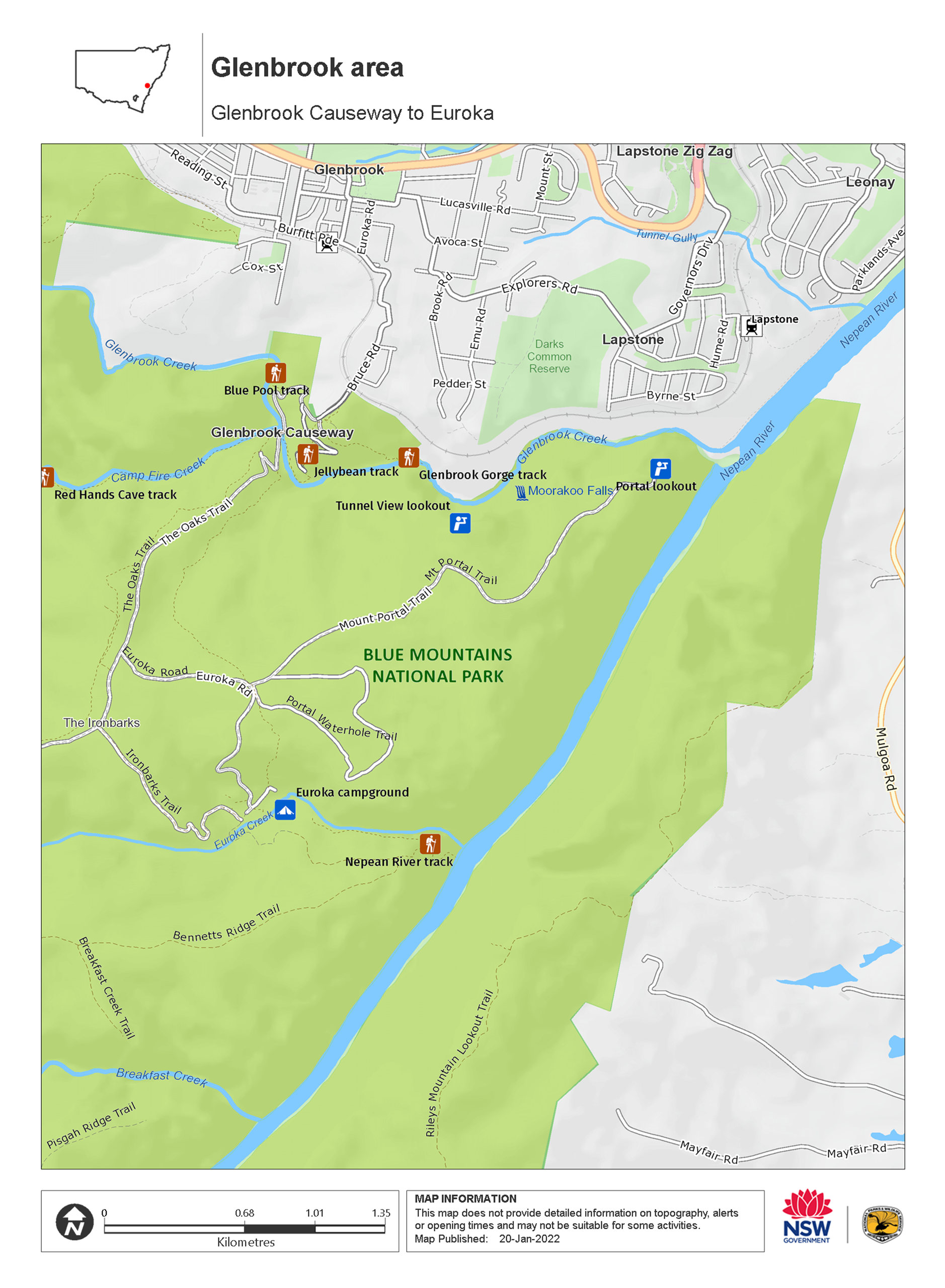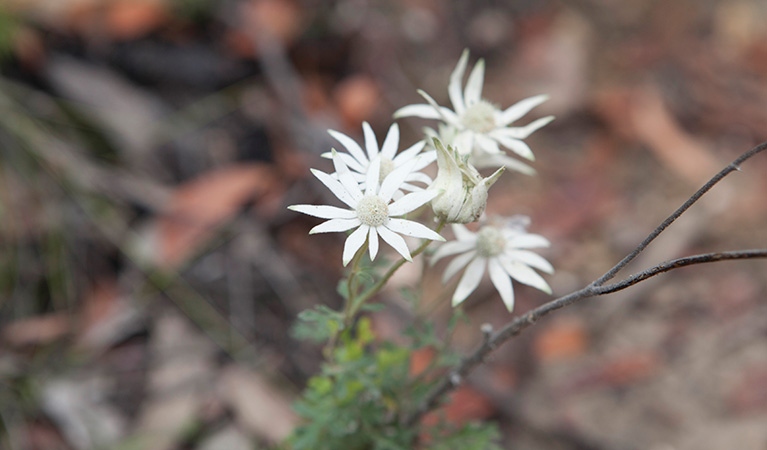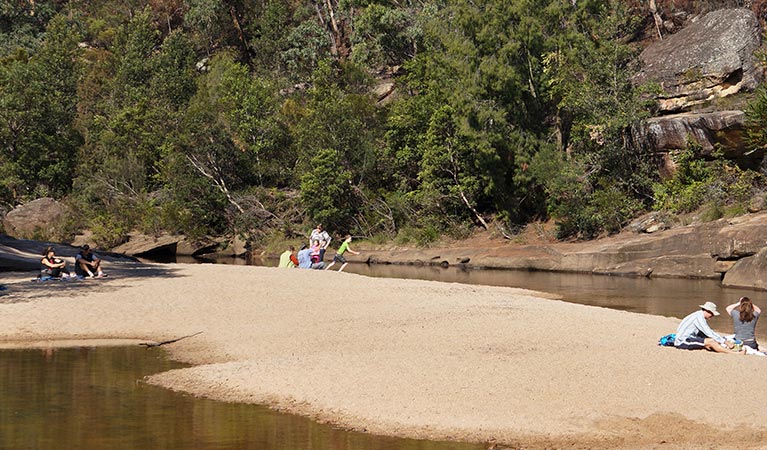Glenbrook area
Blue Mountains National Park
Overview
Glenbrook area is your eastern gateway to Blue Mountains National Park from Sydney. Camp in the wild and enjoy natural swimming spots, Aboriginal rock art, walks and mountain biking, so close to Sydney.
Read more about Glenbrook area
Glenbrook area is a favourite nature escape for families, locals and Sydney daytrippers.
Pack a picnic and head to the sandy beach at Jellybean Pool or the more secluded Blue Pool, both a short stroll from the carpark. Tuck into a leisurely lunch then cool off in the calm waters as currawongs and rainbow lorikeets chatter above.
If you’re feeling active, the car-free Bennetts Ridge fire trail or Woodford-Oaks trail offer safe, well-maintained trails for trail runners, casual cyclists and pro riders. Mountain bikers can also ride the purpose-built 1.5km section of Woodford-Oaks trail, with its graded technical challenges. A shorter option is the mountain bike and 4WD trail along Murphys Road from Woodford to peaceful Murphys Glen campground.
Get a fix of the outdoors along the family-friendly Nepean River walking track. Try the short but challenging Glenbrook Gorge track or intrepid Jack Evans walking track. A visit to the hand stencil rock art at Red Hands Cave is one of the best ways to experience the fascinating Aboriginal culture of the Blue Mountains.
Euroka campground is your best base to explore the area’s tracks, trails, lookouts and waterholes. Pitch your tent among the grassy clearings and tall gums, and fall asleep to the sounds of the bush.
Round off your visit with a ride or drive up to the wheelchair-accessible Mount Portal lookout. Perched atop the sandstone escarpment, you’ll see where the Blue Mountains meet Sydney.
Local alerts
For the latest updates on fires, closures and other alerts in this area, see https://www.nationalparks.nsw.gov.au/visit-a-park/parks/glenbrook-area/local-alerts
Map

Map

Map legend

Contact
- in Blue Mountains National Park in the Sydney and surrounds region
- From the first Sunday in October to the first Sunday in April: park gates are open 8.30am to 7pm.
- Rest of the year: park gates are open 8.30am to 6pm.
-
$8 per vehicle per day applies at the Bruce Road entrance to the Glenbrook area. You can also pay for your visit via the Park’nPay app.
Buy annual pass. -
-
Glenbrook office
02 4720 6200
Contact hours: Entry station is only open on weekends, public holidays and school holidays. - 68 Bruce Road, Glenbrook NSW 2773
-
Email: npws.hawkesburynattai@environment.nsw.gov.au
-
Glenbrook office
-
-
Blue Mountains Heritage Centre and Blackheath office
02 4787 8877
Contact hours: 9am to 4pm daily. Closed Christmas Day. - 270 Govetts Leap Road, Blackheath NSW 2785
-
Email: bluemountains.heritagecentre@environment.nsw.gov.au
-
Blue Mountains Heritage Centre and Blackheath office
Visitor info
All the practical information you need to know about the Glenbrook area.
Maps and downloads
Nearby towns
Penrith (10 km)
Summer is an ideal time to visit Penrith - one of Sydney's best inland aquatic playgrounds. Have fun riding the rapids at Penrith Whitewater Stadium,, visit Sydney International Regatta Centre, paddle on Nepean Gorge in a canoe or relax with a picnic by the Nepean River.
Springwood (14 km)
The Sassafras Gully Loop is one of a number of excellent walks in Springwood. The trail takes you from Springwood Station and past wonderful rock features, dense bushland and waterfalls. It's a nice cool walk in the shade and you're never too far from water.
Learn more
Glenbrook area is a special place. Here are just some of the reasons why:
Plants and animals protected in this park
Animals
-

Yellow-tailed black cockatoo (Calyptorhynchus funereus)
The yellow-tailed black cockatoo is one of the largest species of parrot. With dusty-black plumage, they have a yellow tail and cheek patch. They’re easily spotted while bird watching, as they feed on seeds in native forests and pine plantations.
-

Common brushtail possum (Trichosurus vulpecula)
One of the most widespread of Australian tree-dwelling marsupials, the common brushtail possum is found across most of NSW in woodlands, rainforests and urban areas. With strong claws, a prehensile tail and opposable digits, these native Australian animals are well-adapted for life amongst the trees.
-

Swamp wallaby (Wallabia bicolor)
The swamp wallaby, also known as the black wallaby or black pademelon, lives in the dense understorey of rainforests, woodlands and dry sclerophyll forest along eastern Australia. This unique Australian macropod has a dark black-grey coat with a distinctive light-coloured cheek stripe.
-

Eastern water dragon (Intellagama lesueurii lesueurii)
The eastern water dragon is a subaquatic lizard found in healthy waterways along eastern NSW, from Nowra to halfway up the Cape York Pensinsula. It’s believed to be one of the oldest of Australian reptiles, remaining virtually unchanged for over 20 million years.
-

Lace monitor (Varanus varius)
One of Australia’s largest lizards, the carnivorous tree-dwelling lace monitor, or tree goanna, can grow to 2m in length and is found in forests and coastal tablelands across eastern Australia. These Australian animals are typically dark blue in colour with whitish spots or blotches.
-

Kookaburra (Dacelo novaeguineae)
Of the 2 species of kookaburra found in Australia, the laughing kookaburra is the best-known and the largest of the native kingfishers. With its distinctive riotous call, the laughing kookaburra is commonly heard in open woodlands and forests throughout NSW national parks, making these ideal spots for bird watching.
-

Sugar glider (Petaurus breviceps)
The sugar glider is a tree-dwelling Australian native marsupial, found in tall eucalypt forests and woodlands along eastern NSW. The nocturnal sugar glider feeds on insects and birds, and satisfies its sweet tooth with nectar and pollens.
-

Superb lyrebird (Menura novaehollandiae)
With a complex mimicking call and an elaborate courtship dance to match, the superb lyrebird is one of the most spectacular Australian animals. A bird watching must-see, the superb lyrebird can be found in rainforests and wet woodlands across eastern NSW and Victoria.
-

Superb fairy wren (Malurus cyaneus)
The striking blue and black plumage of the adult male superb fairy wren makes for colourful bird watching across south-eastern Australia. The sociable superb fairy wrens, or blue wrens, are Australian birds living in groups consisting of a dominant male, mouse-brown female ‘jenny wrens’ and several tawny-brown juveniles.
Plants
-

Wonga wonga vine (Pandorea pandorana)
The wonga wonga vine is a widespread vigorous climber usually found along eastern Australia. A variation of the plant occurs in the central desert, where it resembles a sprawling shrub. One of the more common Australian native plants, the wonga wonga vine produces bell-shaped white or yellow flowers in the spring, followed by a large oblong-shaped seed pod.
-

Smooth-barked apple (Angophora costata)
Smooth-barked apple gums, also known as Sydney red gum or rusty gum trees, are Australian native plants found along the NSW coast, and in the Sydney basin and parts of Queensland. Growing to heights of 15-30m, the russet-coloured angophoras shed their bark in spring to reveal spectacular new salmon-coloured bark.
-

Old man banksia (Banksia serrata)
Hardy Australian native plants, old man banksias can be found along the coast, and in the dry sclerophyll forests and sandstone mountain ranges of NSW. With roughened bark and gnarled limbs, they produce a distinctive cylindrical yellow-green banksia flower which blossoms from summer to early autumn.
-

Flannel flower (Actinotus helianthi)
The delicate flannel flower is so named because of the soft woolly feel of the plant. Growing in the NSW south coast region, extending to Narrabri in the Central West and up to south-east Queensland, its white or pink flowers bloom all year long, with an extra burst of colour in the spring.
-

Coachwood (Ceratopetalum apetalum)
Coachwood trees are Australian native plants that grow in warm temperate rainforests along coastal NSW. Also known as scented satinwood, the mottled grey bark of the coachwood has horizontal markings and a delicate fragrance.
-

Blueberry ash (Elaeocarpus reticulatus)
The blueberry ash is a rainforest shrub which produces blue olive-shaped berries and spectacular bell-shaped flowers, which often appear on the plant together. It is a tall slender shrub or small tree found in rainforest, tall eucalypt forest and coastal bushland in eastern NSW, south-east Queensland and Victoria.
-

Grass tree (Xanthorrea spp.)
An iconic part of the Australian landscape, the grass tree is widespread across eastern NSW. These Australian native plants have a thick fire-blackened trunk and long spiked leaves. They are found in heath and open forests across eastern NSW. The grass tree grows 1-5m in height and produces striking white-flowered spikes which grow up to 1m long.
-

Waratah (Telopea speciosissima)
The beautiful waratah is not only the NSW floral emblem, it's also one of the best-known Australian native plants. This iconic Australian bush flower can be found on sandstone ridges around Sydney, in nearby mountain ranges and on the NSW South Coast. The waratah has a vibrant crimson flowerhead, measuring up to 15cm across, and blossoms in spring.
Environments in this area
What we're doing
Glenbrook area has management strategies in place to protect and conserve the values of this park. View the detailed park and fire management documents. Here is just some of the work we’re doing to conserve these values:
General enquiries
- National Parks Contact Centre
- 7am to 7pm daily
- 1300 072 757 (13000 PARKS) for the cost of a local call within Australia excluding mobiles
- parks.info@environment.nsw.gov.au
Contact
- in Blue Mountains National Park in the Sydney and surrounds region
- From the first Sunday in October to the first Sunday in April: park gates are open 8.30am to 7pm.
- Rest of the year: park gates are open 8.30am to 6pm.
-
$8 per vehicle per day applies at the Bruce Road entrance to the Glenbrook area. You can also pay for your visit via the Park’nPay app.
Buy annual pass -
-
Glenbrook office
02 4720 6200
Contact hours: Entry station is only open on weekends, public holidays and school holidays. - 68 Bruce Road, Glenbrook NSW 2773
-
Email: npws.hawkesburynattai@environment.nsw.gov.au
-
Glenbrook office
-
-
Blue Mountains Heritage Centre and Blackheath office
02 4787 8877
Contact hours: 9am to 4pm daily. Closed Christmas Day. - 270 Govetts Leap Road, Blackheath NSW 2785
-
Email: bluemountains.heritagecentre@environment.nsw.gov.au
-
Blue Mountains Heritage Centre and Blackheath office
In this area:
Things to do (51)
- 4WD touring (2)
- Aboriginal culture (3)
- Birdwatching and wildlife encounters (9)
- Cultural heritage (1)
- Cycling (5)
- Environmental appreciation/study (1)
- Historic heritage (4)
- Other experiences (5)
- Photography (2)
- Picnics and barbecues (3)
- Sightseeing (20)
- Swimming (4)
- Walking (21)
- Waterfalls (4)
- Wildflowers (seasonal) (1)

